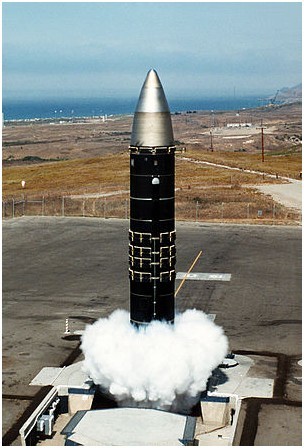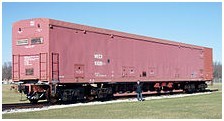
LGM-118 Peacekeeper
Wikipedia | 2013-09-30 17:56

The LGM-118A Peacekeeper, also known as the MX missile (for Missile-eXperimental), was a land-based ICBM deployed by the United States starting in 1986. The Peacekeeper was a MIRV missile; it could carry up to 10 re-entry vehicles, each armed with a 300-kiloton W87 warhead/MK-21 RVs (approx. twenty times the power of the bomb dropped on Hiroshima during World War II). A total of 50 missiles were deployed after a long and troubled development period. They have since been deactivated.
Under the START II treaty, which never entered into force, the missiles were to be removed from the U.S. nuclear arsenal in 2005, leaving the LGM-30 Minuteman as the only type of land-based ICBM in the U.S. arsenal. Despite the demise of the START II treaty, the last of the LGM-118A "Peacekeeper" ICBMs (but not their warheads) were decommissioned on September 19, 2005. Current plans are to switch 500 decommissioned Peacekeepers' W87/Mk-21 warheads to the Minuteman III. Among the reasons cited for decommissioning of the Peacekeeper ICBM was its failure to achieve the program's range objectives.
The private launch firm Orbital Sciences Corporation has developed the Minotaur IV, a four-stage civilian expendable launch system, from the Peacekeeper, using old Peacekeeper components.
Development and deployment

Technicians secure a number of Mk21 re-entry vehicles ("dunce-caps") on a Peacekeeper MIRV bus.
Minuteman
Deployment of the Minuteman ICBM began in 1962 and proceeded rapidly. Limited accuracy with a circular error probable (CEP) of about 0.6 to 0.8 nautical miles and a small warhead of less than 1 megaton meant the system was unable to attack hardened targets like missile silos. This limited these early models to attacks on strategic targets like cities and ports, and the system had little or no capability as a counterforce weapon.
In such an environment, there was the possibility that a Soviet first-strike with a limited number of warheads against the US ICBM fleet would leave the US with no missiles able to attack their remaining missile fleet. This would encourage the US toward an immediate launch to ensure the missiles were not hit on the ground. But as these were targeted primarily against cities, it would require trading a purely military attack against a civilian response, something the politicians considered to be a serious problem (part of the flexible response doctrine). By April 1964 the US had more ICBM's on active alert than strategic bombers, which exacerbated this concern.
Continued work on the Minuteman led to the Minuteman II specification, set in 1962. The II included two key improvements; the new NS-17 inertial navigation system improved the CEP to 0.34 nm, enough to allow it to attack hardened targets. Just as important, the guidance system allowed for the inclusion of eight pre-selected targets. This allowed the system to ride out a first-strike, re-target on just the remaining enemy missiles, and launch. Against a limited attack, all the Soviets could muster at that time, this offered the US a major strategic advantage.
It did not, however, fix the problem of a full-scale attack against the entire ICBM fleet, which would be possible with Soviet improvements. With the ICBM force now critical to the strategic mission, the Air Force became increasingly interested in new ways to keep the missiles safe from such an attack.
Golden Arrow
The Air Force had depended on the engineeering firm TRW during the early days of the development of their ICBM force. In 1960 a number of TRW and other engineers involved in the ICBM program formed Aerospace Corporation, initially working on the Mercury spacecraft, X-20 Dynasoar and various ICBM projects. In 1964, the Air Force asked them to consider a wide variety of survivable ICBM solutions, under the name "Golden Arrow".
The project considered road, rail, submarine and air-launched weapons. One of these suggested an air-launched ballistic missile system named "Golden Arrow". The proposal called for an enormous (for the day) turboprop-powered aircraft with two-day endurance carrying up to eight missiles that would be dropped out the back, parachuted to the vertical, and then launched. As part of the same study, Aerospace also considered a missile and launcher combination that was small enough that two could be carried in existing C-141 Starlifter aircraft, which could land at practically any airport, setup and launch. These would be deployed to the US's widespread airports during periods of heightened tensions.
Finally, they also considered conventional missiles in "super hard" silos, buried under the southern side of mountains. As the enemy warheads would approach from the north, they would impact the north side of the mountains before they could hit the silo itself. Properly positioned, this would keep the explosions at least 5,000 feet away from the silos; it was expected that silos able to withstand multi-megaton explosions at one mile could be built, although this was considered to be an area of some uncertainty. This system had the advantage that the basing would be immune to changes in accuracy or speed of the attack, only enormous increases in yield could overcome this physical barrier.
They proposed 100 missiles in three such bases, and expected that at least one base would be able to survive even an all-out attack. However, if such a force of approximately 30 missiles was going to be a reasonable deterrent, each missile would need to carry 20 or more warheads. To launch them, the study introduced the "ICBM-X", a massive new 156-inch diameter design, well over twice the diameter of the existing LGM-30 Minuteman, and larger even than the Titan II "heavy" design at 120-inches.
Any of the Golden Arrow concepts would be extremely expensive, and in the era of Robert McNamara's US Department of Defense, cost was as important as any other consideration. As Alain Enthoven put it, "Our gross national product, though large, is limited. If we attempted to develop and procure a dozen or more distinct different nuclear delivery systems… we doubtless would end up squandering our resources and not doing a good job on any of them." Golden Arrow, along with many similar proposals from other firms, proceeded no further, in favor of the Minuteman II.
WS-120A
Another outgrown project from the ICBM-X was a smaller version limited to 10 to 20 warheads, known initially as WS-120A and later as BGM-75 AICBM. The missile was small enough to fit in existing large silos, like those for the Titan II, but was otherwise similar in concept to the ICBM-X, with a circular error probable (CEP) of about 0.1 miles, and especially the ability to be quickly re-programmed to attack any targets needed. In comparison, the Minuteman II had a selection of eight targets, any one of which could be quickly selected for attack, but otherwise selecting a target outside this pre-computed list was not something that could be done "on the fly". WS-120A's preferred basing mode was a super hardened shelter, but dispersed mobile options were also considered.
However, like Golden Arrow before it, WS-120A's advantages found themselves being diluted by the new Minuteman III. The Minuteman III used the new NS-20 inertial navigation system (INS) with a CEP of 0.12 nautical miles, and three warheads with an expanded collection of radar countermeasures. Although the system did not include the ability to be rapidly-retargetted, this capability was under development and started deployment in 1972, before the planned 1975 introduction date of WS-120A. When it was fully deployed in 1978, the entire ICBM fleet could be entirely reprogrammed in 10 hours.
INS advances
Since the late 1950s, engineers at the Charles Stark Draper Laboratory had been working on a new type of inertial platform that replaced the mechanical gimbals with a sphere floating in a thin layer of fluorocarbon fluid. The so-called "flimbal" (apparently for "FLoated Measurement BAL")[16] would offer unprecedented accuracy and would be free from "gimbal lock", a problem that caused conventional platforms to "tumble" and lose their accuracy. Like the ICBM-X, there was little development as there appeared to be no need for a platform with the sort of accuracy the flimbal provided, and the expense of developing the system would be extremely high.
In spite of official disinterest, during the late 1960s Kenneth Fertig managed to arrange some funding through the Air Force for the "SABRE" project, short for "Self-Aligning, Boost and RE-entry" INS. The name referred to the concept that the system would be so accurate and free from the effects of mechanical shocks and jarring that it would not require any other form of "fixing" in flight. It would retain its accuracy even through the rough conditions during launch and re-entry. In comparison, existing INS's would become inaccurate during these periods, and required midcourse fixes from star shots or TRANSIT measurements for fine tuning.
Counterforce worries
During the late 1970s, the Soviet Union fielded a large number of heavy (defined by throw weight), increasingly accurate MIRV ICBMs like the SS-18. These had the accuracy and numbers needed to be a serious threat to the survival of Minuteman III missiles in their silos. If the Soviet Union launched a sneak attack and the US did not respond immediately, the majority of their missiles and strategic bombers might be caught on the ground. A credible deterrent force would remain, but such a force might not have enough warheads left to attack both the remaining Soviet fleet and cities and other military targets.
In such a situation, the US would be left with two uncomfortable responses. If they chose to respond in kind and attack the remaining Soviet missile fleet, there would be little to respond with if the Soviets immediately launched against US cities. The other option would require the US to be the first country to launch an attack on civilian targets, an attack that was both morally reprehensible as well as against stated policy. SLBM's, like the new UGM-73 Poseidon, would be immune to a counterforce attack, but their lower accuracy meant they were suitable only for attacking cities or large military targets like shipyards.
This worrying scenario led to the effort to develop a new land based missile having the multiple requirements needed to be an excellent counterforce weapon: accuracy, first strike survivability, and the MIRV capabilities needed to ensure even a small number of survivors would be able to attack the remaining Soviet missile fleet. The Minuteman III simply did not have this combination of features. However, it was clear from the outset that such a missile would be unable to neutralize the Soviet ballistic missile submarines on patrol. Like the US fleet, these missiles would be an excellent second-strike option against cities.
MX
The outcome of this thinking was obvious from the start; in 1971 the Air Force started a "requirements development" combining the ICBM-X and SABRE concepts into a single platform, "Missile, Experimental", or MX. The new missile would be so accurate and carry so many warheads that even a few survivors would be able to destroy enormous numbers of any remaining Soviet force. The specifications for MX were fixed in February 1972, and the "advanced development program" started in late 1973. At the time, MX was to be based in existing Minuteman silos, in keeping with the original ICBM-X concept of MX as essentially a bigger Minuteman.
For MX, the Draper Laboratory developed SABRE into the "Advanced Inertial Reference Sphere" (AIRS). AIRS would have a drift rate of only 1.5 x 10-5 degrees per hour, allowing it to be referenced to an external point, like the silo wall, and then left for extended periods of time. Over the period of the flight the drift would be so low that any inaccuracies introduced by the drift could account for a maximum of 1% of the warhead's final accuracy - the rest would be due to downstream issues like the measurement of the firing of the rocket engines, minor differences in warhead construction, and unavoidable randomness in the atmosphere. The Air Force also contracted with Autonetics for a backup design using mechanical gimbals, the "Advanced Stable Platform" (ASP). In May 1975 the first hand-built AIRS was transferred from Draper's laboratory to Northrop for further development.
Basing options

Time exposure shot of testing of the Peacekeeper re-entry vehicles at the Kwajalein Atoll, all eight fired from one missile. With live warheads, each would have the explosive power of twenty Hiroshima-sized (Little Boy) nuclear weapons
In 1976, Congress refused to fund MX using a silo-based system on grounds of vulnerability, and the project was halted. Several new proposals were made for alternate basing arrangements, including mobile basing in railway cars that would be sent out into the nation's rail network during times of heightened threat levels, and more complex systems of deeply buried silos under mesas that would include systems to quickly dig themselves out after an attack. Eventually, the program was reinstated in 1979 by President Carter, who authorized deployment of 200 missiles throughout eastern Nevada and western Utah. The deployment would occur in a system of multiple protective shelters linked by underground or aboveground roads, the so called "Racetrack" proposal. However, local opposition in Nevada was intense, and the concept gained a powerful enemy in the form of Senator Paul Laxalt. Initially support was high in Utah, especially in the Beaver County area; although opposition increased dramatically following a statement of disapproval by the leaders of The Church of Jesus Christ of Latter-day Saints.
When Ronald Reagan took office, Laxalt's close ties with Reagan proved useful, and Reagan canceled the new shelter system in 1981, calling it "a Rube Goldberg scheme". He proposed deploying an initial force of missiles in existing Titan II silos, removing those now outdated missiles from service. The silos would be modified for much greater strength, and a number of Minuteman III silos similarly adapted over time to bring the force to a total of 100 missiles. Additionally, he suggested funding development of three additional basic concepts, airborne drops from cargo aircraft, anti-ballistic missile defences, or basing new silos deep underground or on the south side of mesas ("reverse-inclination basing").The later two quickly proved unacceptable for various reasons, while testing of the air-drop concept was pursued.
In its place came the "dense pack" concept which would speed deployment. The dense pack idea involved building super-hardened silos that would withstand more than 10,000 psi (70 MPa) of overpressure, compared to 2,000 of the existing silos, or 5,000 psi for the upgraded versions originally proposed. This extra hardness can be easily offset by minor increases in warhead accuracy. Key to dense pack, then, was to space the silos so close together, about 1,800 feet (550 m), that warheads attacking one silo would destroy others incoming to attack the same pack. This "fratricide theory" was fundamentally flawed due to the expected relative ease with which the Soviets could modify their warheads and circumvent this design. Congress again rejected the system.
A compromise was eventually developed in mid-1983. Under this scheme, 100 missiles would be deployed in existing Minuteman silos to show "national will". The plan also called for the removal of the venerable and accident-prone liquid fuelled Titan II from use. However, this did not address the problem the MX was originally intended to solve, providing high survivability. This would later be addressed through the re-introduction of the "rail garrison" concept, with twenty-five trains each carrying two missiles. This system was expected to be operational in 1992. The supposed counterforce gap, then being widely talked about on television, also resulted in the schedule for silo deployment being moved up, dropping the production time from 44 months to 29.
Additionally, the plan also called for the development of an entirely new missile, which would emerge as the MGM-134 Midgetman. The Midgetman deliberately carried only one warhead and was highly mobile. Countering a single Midgetman would require the Soviets to blanket an area around its last known position with warheads. Even if this was successful, they would destroy only a single warhead. Faced with this choice, it was expected the Soviets would instead expend their warheads on easier targets.
Deployment

Retired Peacekeeper garrison car prototype at the USAF National Museum.
The new ICBM missile was originally planned to be called "Peacemaker", but at the last minute was officially designated the LGM-118A Peacekeeper. It was first test fired on 17 June 1983, by the Air Force Systems Command Ballistic Missile Office (Norton AFB, CA); 6595th Missile Test Group (Vandenberg AFB, CA Strategic Air Command); and Martin Marietta, from Vandenberg AFB, California Test Pad-01, traveling 4,200 nautical miles (4,800 mi; 7,800 km) to strike successfully in the Kwajalein Test Range in the Pacific. The first eight test flights were launched from an above ground canister on TP-01, with the remaining test and operational Strategic Air Command flights from silos (LF-02, -05, & -08) all located on North Vandenberg AFB. A total of 50 flight tests were accomplished.
The operational missile was first manufactured in February 1984 and was deployed in December 1986 to the Strategic Air Command, 90th Strategic Missile Wing at the Francis E. Warren Air Force Base in Cheyenne, Wyoming in re-fitted Minuteman silos. However, the AIRS was not yet ready and the missiles were deployed with non-operational units. AIRS had 19,000 parts and some of these required as many as 11,000 testing steps. Bogged down in paperwork due to government procurement policies, managers started bypassing official channels and buying replacement parts wherever they could be found, including claims that some of the parts were sources at Radio Shack. In other cases, managers had created false shell companies to order needed test equipment.
When these allegations were released by 60 Minutes and the Los Angeles Times, the fallout was immediate. Northrop was slapped with a $130 million dollar fine for late delivery, and when they reacted against employees they were countersued in whistleblower suits. The Air Force also admitted that 11 of the 29 missiles deployed were not operational. A Congressional report stated that "Northrop was behind schedule before it even started" and noted that the Air Force knew as early as 1985 that there were "serious system deficiencies as well as a lack of effective progress".They complained that the Air Force should have come clean and simply pushed back the deployment date, but instead, in order to foster the illusion of progress, the missiles were deployed in a non-operational state.
The first prototype AIRS, by then known more generically as the Inertial Measurement Unit, or IMU, was delivered in May 1986, 203 days late. It was not until July 1987 that the first production AIRS were ready to ship, and the complete supply for the first 50 missiles was not complete until December 1988. Given these delays, and increased performance of the UGM-133 Trident II, Congress had already cancelled the 100-missile option in July 1985. In that decision, Congress limited the deployment of Peacekeeper ICBMs to 50 missiles until a more "survivable" basing plan could be developed.
Development of the rail garrison system was carried out in parallel. However, budgetary constraints and the dissolution of the Soviet Union led to its being scrapped. The National Museum of the United States Air Force has a rail garrison box car on display on the museum grounds east of the main display hangars and developmental remnants of the program can still be found at Vandenberg Air Force Base.
The project had already cost around $20 billion up to 1998 and produced 114 missiles, at $400 million for each operational missile. The "flyaway" cost of each missile was estimated at 20 to 70 million dollars. The total combined firepower for all 114 ICBMs was rated at around 342 megatons, or 342 million tons of TNT.
Share this page



















